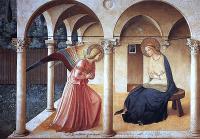
St Luke’s story of the Annunciation has been a favourite with artists who have imagined the scene in various ways. This picture is by Fra Angelico, who lived in the fifteenth century. It is similar to many others which depict Mary in prayer. What this suggests is that Mary was always listening to God. We really know nothing of her earlier life but it is likely that, as she grew up, she became increasingly aware that God was calling her to do something really special. At the same time she was doing what a normal young Jewish woman would do. She was getting married and in fact was solemnly betrothed.
Last week we were given a picture of what the Messiah would be like. This week the first reading speaks about the promise made to David that his throne would last forever. David was idealised by the Jewish people in the same way as King Arthur or Friedrich Barbarossa. He was a great sinner but was beloved by God and faithful to him. In a sense he represents the people of Israel both in their waywardness and in their fidelity as the chosen people. Mary, on the other hand (celebrated as the Immaculate Conception), represented the flowering of all that was best in the Jewish people. At the Annunciation it became clear that not only was her son to be a descendant of King David but he was also to be God’s son. Her "Yes" brought about the fulfilment of God’s plan, and in her the Old and New Testaments were united.
“Mary had every right to rejoice in Jesus, for in one and the same person he would truly be her Son and Saviour.” (St Bede)